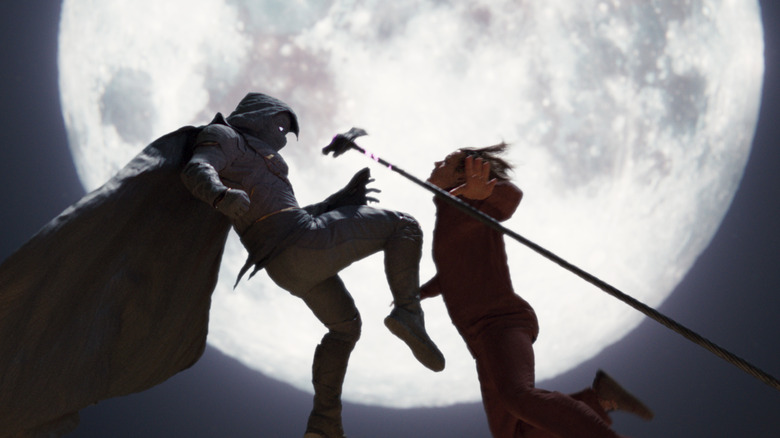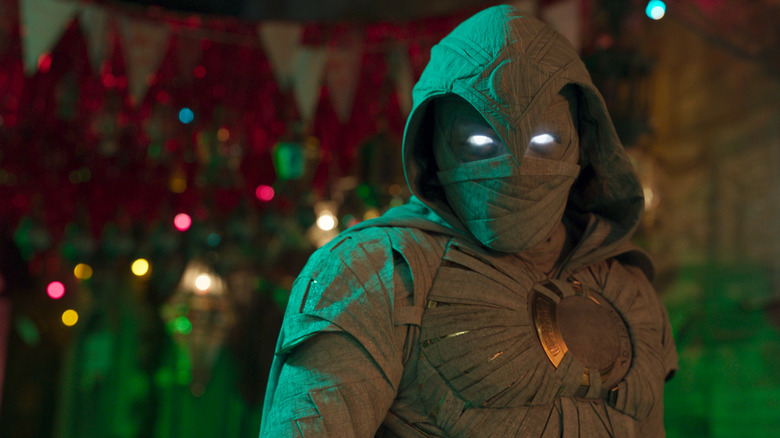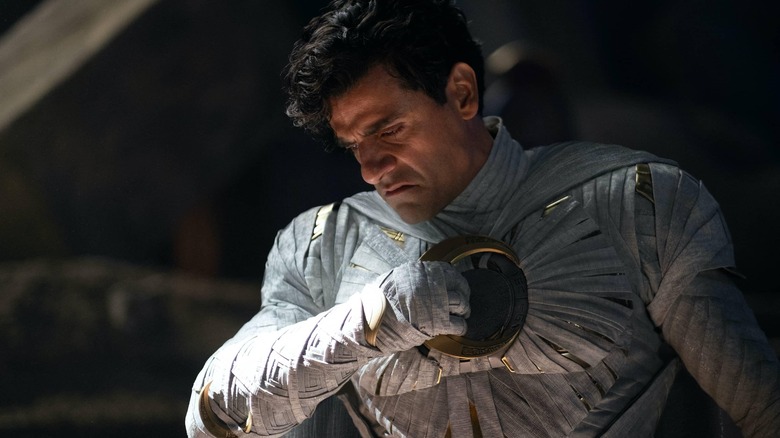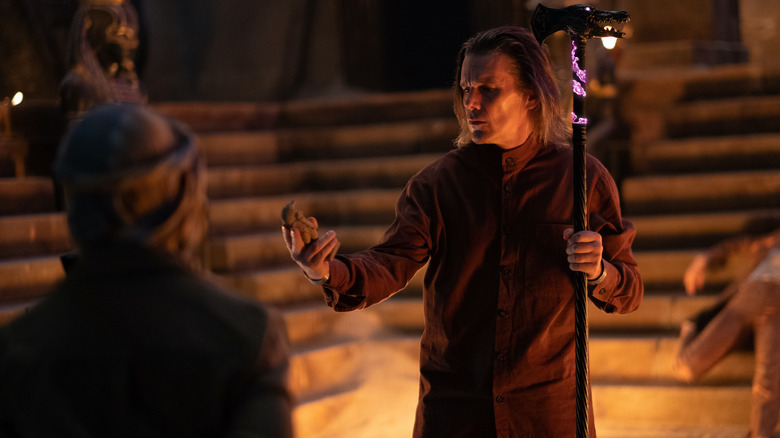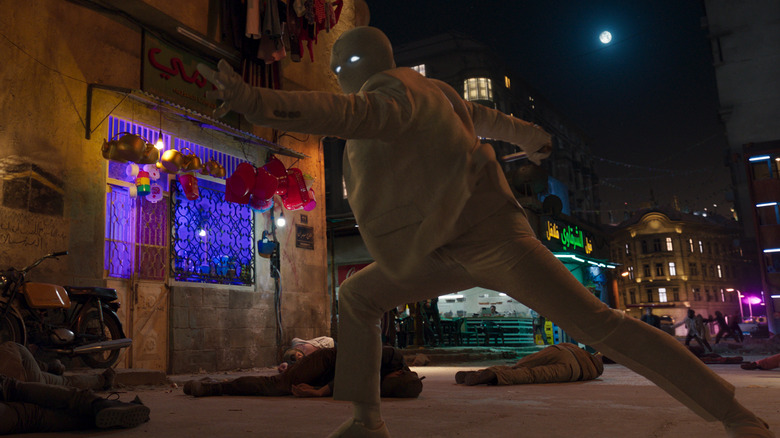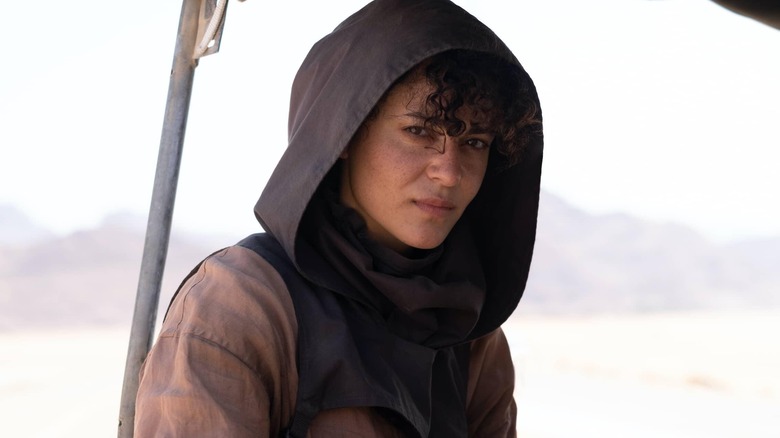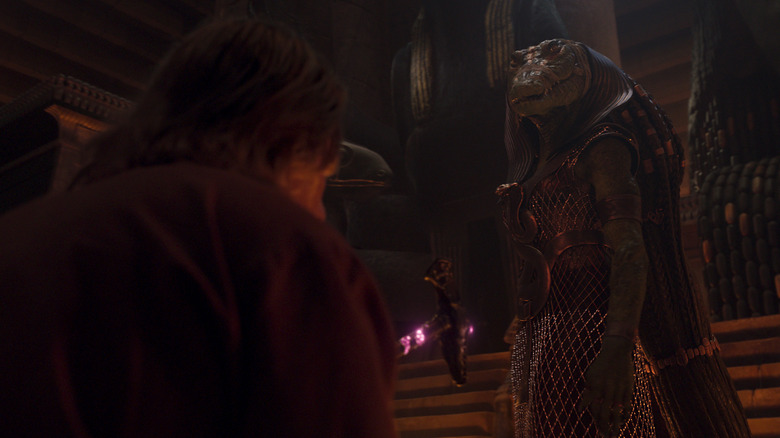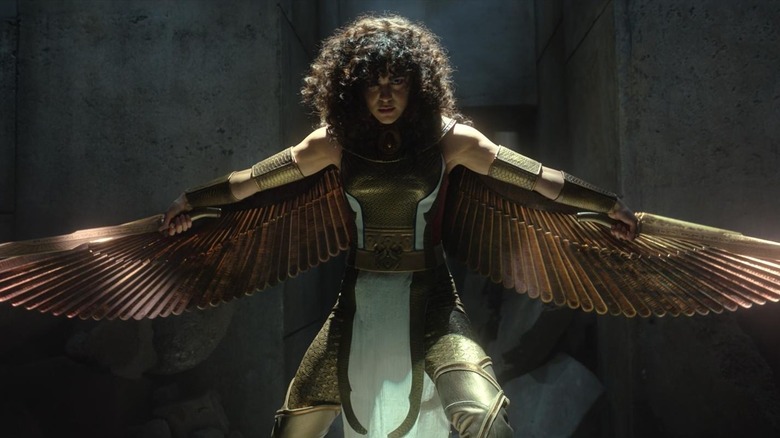Moon Knight Costume Designer Meghan Kasperlik On Ammit, That Scarlet Scarab Reveal, And More [Interview]
You've seen her dizzying array of tremendously hard work, you've enjoyed the fruits of her and her entire creative team's labor, and you've even heard directly from her own mouth about all the attention to detail that went into crafting the costumes featured prominently throughout Marvel's "Moon Knight." Costume designer Meghan Kasperlik's talent and ability speaks for itself, helping to elevate the Oscar Isaac-led Disney+ series to even greater heights. Through a savvy mix of in-house metalsmiths, painters, dying teams, and 3D printing, the tireless crew behind the scenes used every resource at their disposal to bring so many otherworldly outfits and designs to life, from the Moon Knight and Mr. Knight costumes, to the supernatural, CGI-heavy looks for Ammit and Khonshu and Tawaret (though every costume for every VFX character was still made practically first, impressively enough). Even the much more drab and mundane look for cult leader Arthur Harrow (Ethan Hawke) required Kasperlik's touch.
Now over two weeks removed from the finale of "Moon Knight," Meghan Kasperlik was gracious enough to talk with /Film once more, this time with any and all questions about spoilery characters fully on the table. Personally, I've found that interviewing below-the-line crew — even via Zoom — provides a uniquely eye-opening look into the nitty-gritty details that go into the under-discussed elements of a production. Kasperlik comes across as particularly impassioned about her craft, and we discussed everything from her past experiences on superhero movies, putting her own stamp on "Moon Knight," collaborating with Marvel, and the extensive process of making Scarlet Scarab's (May Calamawy) costume worthy of Marvel's first Egyptian superhero.
This interview has been lightly edited for clarity.
'The costumes are iconic, so they last forever'
Obviously "Moon Knight" wasn't your first major superhero project. You've done "The Amazing Spider-Man 2," "The Dark Knight Rises," and even HBO's "Watchmen" show. Did any of that factor in as a prerequisite when you first joined "Moon Knight?" Did Marvel look at that and say, "Yes, you can handle this, you've done this before"?
I'm sure that played a little bit into it. I think any time you have that experience, I think it only benefits you. I definitely used the experience that I had from doing those shows to incorporate it into how to better the suit for Oscar and to better the suit for May to make sure that it was comfortable and functional and all of that, so it definitely helped me.
It definitely helped in speaking with Oscar about the hood for Moon Knight. There were lots of discussions about how it should lay and how it should be and the shape of it and everything. And that was a discussion that I had with Oscar and then [director] Mohamed Diab. And it got to the point where Oscar's like, "Meghan's got the hood, she's good, she's going to be okay, she knows what she's doing." [Laughs] So it definitely played to my benefit, in the sense that I've done it before.
So recently I had the chance to talk to one of the cinematographers for "Moon Knight," Andrew Droz Palermo, and I had to ask him about creative freedom with Marvel. I'm curious, for a costume designer, did that ever factor into any of your discussions with the Marvel team?
Well, the costumes are iconic, so they last forever [laughs], and with Marvel, they do have a [visual development] department that works in-house around the clock to incorporate that into the design. So, by the time I came on, there were some renditions of the design and then it was factored down from there. The [studio] notes mostly came with color. I would say the rendering is actually the shade of what the costume was and there was a big discussion about the Moon Knight costume about the color. And with the Scarlet Scarab costume, there were different design elements, and so there was a moment where certain things weren't working and we had to go back and alter a few things.
So, the superhero costumes definitely are more of a discussion. The contemporary costumes, for Mark and Steven, those were early on in discussion and then by the time I started fitting Oscar and also fitting Ethan, then it showcased what was possible within that contemporary costume. So, it wasn't a negative situation, it was more about, "Let's explore and let's see what can happen."
'I wanted to make sure that not only is it evolving in the MCU, but it's also putting my stamp on it'
Did you ever look back at previous installments of the Marvel Universe and consciously try to make this look different from what came before?
Yeah, I wanted to make sure that not only is it evolving in the MCU, but it's also putting my stamp on it. I think there's been amazing designers before and on other projects that have put their stamp on those shows, and I just wanted to make sure that it had incorporated not only what it needed to showcase in the MCU, but also a little bit of my personality in there. I like a lot of texture in my designs and a lot of depth, so I wanted to make sure that the fabric is layered, not only just in layering the physical fabric, but also that there's dimension to the 3D printing and what could be possible on this.
There's that rule that you put five things on and you take one thing off and I think on Marvel, you put five things on and question if maybe you can put the sixth thing on as just one little extra detail. So, that was exciting that I was able to explore in that manner. And really, if we could put an extra detail on or an extra texture, it was about making it work and [seeing] what was possible. It was really exciting to evolve and see where the next stages of the MCU could go.
Was it a challenge that so much of this was built-in? You're working based on what the comics have already established — do you find that restricting at all, or did it allow you to find your own way to it even within those parameters?
I didn't find it restricting. I find that there's still so much that can be done. You're taking a two dimensional character and making it 3D. In the comic, it's so amazing because they can bend their body in whatever way is possible, but in real life that doesn't happen [laughs]. So, it's all about putting the puzzle pieces together and figuring out what can actually be done, so I find it exciting.
'It was more about taking it from nature and architecture and fashion'
Now, obviously you had the entirety of Egyptian culture and mythology to look at and draw on for inspiration. Did you ever look to other movies and shows in general, not necessarily superhero movies, just anything that you might have looked at and brought to this?
I know a lot of DPs and cinematographers and a lot of directors reference a lot of other films. I like to reference a lot of architecture and nature and history or fashion. I had a fashion background before I got into costume design. And I like to have those as a lot of references, just because I feel that there's so much to say in that element as well. So, I didn't really necessarily take it from other shows and films, it was more about taking it from nature and architecture and fashion.
Any specifics, off the top of your head?
I think a lot of the contemporary clothes, what I did is I looked up a lot of designers — and not necessarily designers that I liked, but I just went through and started looking at a lot of images in general about how the body was framed and sculpted with the fabric. So, it was more about where my eye went versus an actual, physical designer.
I know there's been a few people who have asked me and I didn't take inspiration from any other films or any other costume designers, per se. I was able to briefly work with Lindy Hemming on "The Dark Knight Rises." That was one of the people that worked on it towards the end and I just think she was such an inspirational costume designer and always puts her take on it and her personality, so I always look to her and iconic costume designers. I think Sandy Powell, any costume designer aspires to have a career similar to hers or to do a number of things that she did. So I look at other designers work, but I never tried to copy it.
'The process is quite expensive'
With "Moon Knight" specifically, it's clear just from looking at the costumes on display, the amount of work that got put into it on you and your team's part. I know it involved 3D printing, metalworking, sneaking in all those tiny details wherever you could. Could you expand on that process a little more?
I was really fortunate to work with some amazingly talented people within my department and also people that we hired out. For the Moon Knight costume, I worked with FBFX, who pieced it all together and they really did most of the 3D printing. The exciting thing about that is that the Moon Knight fabric was completely made, in a sense. It started out as a Eurojersey stretch, and that's what a lot of the superhero costumes are made out of, because you need that stretch to be able to do a lot of the moves. But we used it for the top portion as well, to make the fluidity of the top and the bottom. On that is different levels of a 3D print and the 3D print takes a really long time to set and dry and all of that [laughs]. The process is quite expensive.
But the exciting thing is, there'd be a 3D print put on the dyed Eurojersey, which is a stretchy fabric, and then that would dry and then there would be a gold foil that was put on top of it, so that it would shimmer in the light. And then there were other pieces that had another 3D print put on it, so that there was depth to the pieces and it just wouldn't go flat. So that part was really cool and different patterns were put into that. I had an in-house metalsmith that made — anything that was jewelry, we made in-house and we made it in metal. Then, if it was on a stunt person, we cast it in the rubber form so that it could be safe to use. That was really exciting, because that's a treat you don't always get: An in-house metalsmith.
And I had an in-house painter and an in-house aging/dying team, so they were doing all the lapels on the Mr. Knight costume, they were all these raised puff print that we would make the suit, lay the lapels in after they were printed, put it on, the ties were all printed. So, it was really exciting that all of the elements could come together, because you don't have that on every job.
'You're really creating and building that character in the fitting room'
You've talked before about getting input from Oscar and from the other actors about creating their outfits. How does that apply to working with Mohamed Diab and other directors on the show, the writers, other department heads, maybe even Kevin Feige himself? Just how collaborative was this process for you?
It's a very collaborative process. It's an amazing team at Marvel and they're very open to everyone getting together and having these discussions. We were doing them over Zoom so while I was prepping, we would have Zoom conversations with everyone across the world until we all came together when we filmed in Budapest. So that part was really phenomenal because it's such a collaboration. I like to collaborate with the director and the DP because I'm really interested in the lighting and how the costume's going to be lit. Are we going to be in a dark space? Is it going to be a gritty tone? Is it going to be blown out? Because that will determine how I create the costume and it really has a lot of input into what will be done. And I also love to work very closely with the production designer, because the set will really inform how the costume is perceived and what we can do. So, that's amazing.
But the first time that you work with the actors, sometimes one of the first conversations they have is about the character, so you're really creating and building that character in the fitting room. It's extraordinarily important to sit down and have these conversations about how the actor sees it, how the director plays into the character and creating the character, but also how the costume really informs the character. It's such an amazing collaborative effort, and it was a great one to do on this job.
'Any character that is CG, I built a costume for'
After signing on to "Moon Knight," how early in the process did you discuss all of the elements for a character like Ammit, and just how extensive was that process over the course of production?
Even though Ammit was seen in the last episode, it is a character that was discussed early on, pretty soon after I signed on. Because any character that is CG, I built a costume for. So Ammit, Taweret, Khonshu, the Heka Priests, those all had CG elements to it but were fully-functioning costumes that actors were on set and performed in. I was really excited by Ammit and Taweret because I thought that was such a great, amazing challenge. With Ammit's dress, the dress is completely hand-beaded, so it is a leather corset with a shimmery fabric of a skirt that has luminescence to it. But then the overlay on it is based off of an Egyptian dress that's a very famous, triangle-beaded, hand-beaded dress. So, it's based off of that.
And my leather worker in-house actually said that she could make it. So it took her about two weeks [laughs], she made the entire thing and she hand-tied off every single bead and had it on a board and it was like a graph. It was amazing to see her progress throughout. And it has four different colored beads in it, so you see the luminescence and you see it moving, so that was truly amazing. And then my metalsmith made this cobra that projects out of the body that is — I hope it gets displayed, because it is so real looking at it. It was really phenomenal when it was all together.
And then we hand-made all the jewelries, made the braiding, the hair pieces, everything was made. And then Sean Faden and his team with visual effects did an amazing job really capturing all of the details in the costume and helping with all the CG elements and the fighting sequences.
With all-CG characters like that, how does that inform what you're doing? Do you have to talk with the VFX team to make sure that the costume is practical, or are you just looking at the visual side of it and what looks best on camera?
No, it's all-encompassing. Early on I said, "Is this actor going to wear this costume or is it going to be a motion capture suit or green suit?" And they're like, "No, the actor will actually wear the costume." So, the amazing thing is on that netted beaded dress, it was actually on a stretch cording. So that the actor could fully move in it. It was amazing, when she was kicking, the dress was actually extending. It was made in a way that it would be fully functional for the actor to wear, but then they captured all of the details, so it was pretty phenomenal.
'The reveal was the special moment'
With Scarlet Scarab and that big reveal, it's actually built into the dialogue a few minutes before where even Taweret says, "I have a fabulous costume in mind" and it's raising the level of expectation even higher. Did that put a little extra pressure on you to really deliver with the reveal?
I was a little nervous about the costume, because I wanted to make sure that we were making it extraordinarily special and showcasing ancient Egyptian moments, but also the empowerment of Egyptian women. It was really important to me that the costume be — I don't want to say "extra special," but absolutely, I was representing the Egyptian women and Egyptian culture. So that was really important.
We had little elements and little design elements that were incorporated that were part of artifacts that I found in my research and the scarab that is on Scarlet Scarab's chest. Her wings are down because she does a wing reveal, but the wings that are on Taweret, her wings are out on the beetle that is on her chest.
So, it's about taking those little moments and incorporating and transitioning from the avatar to the god to the avatar. So, that was important and also making sure the suit functioned [laughs], because the wings are fully CG and Sean Faden and has team did an amazing job, because it truly really makes the costume special. But there are so many different elements incorporated into the costume, and then the costume was hand-painted in a way that I think was really beautiful and May was super happy, so that was very exciting.
What was your favorite part about designing that outfit?
I think the reveal was the special moment, not just for the audience, but also for May and myself when we saw it on camera. Because you see it in person and when you're building it, you're like, "It's cool, it's great, but what will the fans think? What will everyone think?" When it was getting such an amazing response, I was like, "Okay we did it." We made the best costume that we could make for this reveal, so I'm incredibly proud of my team for creating that and working together to do it.
The first season of "Moon Knight" is streaming on Disney+.
